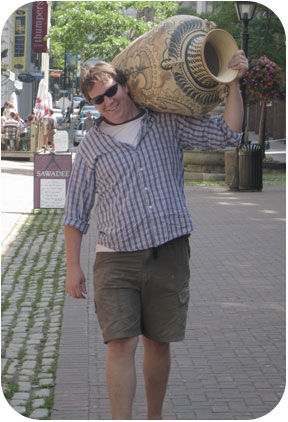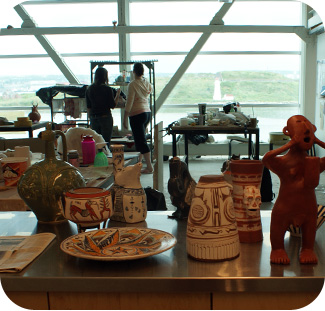|
Welcome to Making History
 Some years ago I had a dream about walking through the history of ceramics. I wanted to stand in a room and see how pottery changes over the years, through different countries, and see the influences of trade and natural resources. I wanted to see whole in front of me what I understood in bits and pieces. Hence, the "Making History" course was born. I decided to teach a class where students would make historical pottery; they would research the building techniques, clays and glazes of iconographic pottery from all over the world. They would make these objects to understand, to learn how to see, and to learn how to make. I wanted the students to work on something outside of themselves; work not based on their own self-expression or ego, but based simply on learning through making and through researching, and on the sheer pleasure of re-discovering things that have come before. This study would culminate in a large-scale exhibition of all of these objects, arranged within a timeline and within geographical relationships. Some years ago I had a dream about walking through the history of ceramics. I wanted to stand in a room and see how pottery changes over the years, through different countries, and see the influences of trade and natural resources. I wanted to see whole in front of me what I understood in bits and pieces. Hence, the "Making History" course was born. I decided to teach a class where students would make historical pottery; they would research the building techniques, clays and glazes of iconographic pottery from all over the world. They would make these objects to understand, to learn how to see, and to learn how to make. I wanted the students to work on something outside of themselves; work not based on their own self-expression or ego, but based simply on learning through making and through researching, and on the sheer pleasure of re-discovering things that have come before. This study would culminate in a large-scale exhibition of all of these objects, arranged within a timeline and within geographical relationships.
I have taught at the Nova Scotia College of Art and Design twice before and I know that NSCAD students are extremely talented, thoughtful, ambitious and always up for working hard. In addition, when I was a student, Professor Walter Ostrom helped me understand the importance and profound influence that the history of ceramics has on our understanding of clay today. Teaching this course at NSCAD is a way of paying homage to Walter Ostrom's great dedication to his students and the study of historical ceramics.
 I am in no way an historian. I am easily seduced by what something looks like, and have a modest understanding of the culture behind all of these pots. To teach a class like this, I needed a co-pilot who had taught ceramic history and who also had tremendous facility with clay and a broad knowledge of ceramics. Luckily, Margaret Bohls was willing to undertake this adventure and joined me in Halifax in early July 2008. Her knowledge of ceramic history is superb and her studio ceramics knowledge is extensive. The success of the course comes from her experience and good nature. Throughout the course, Margaret gave a series of 1-2 hour slide lectures moving across the geography and chronology of ceramics. She grounded all of the wild making of pottery within a context. I am in no way an historian. I am easily seduced by what something looks like, and have a modest understanding of the culture behind all of these pots. To teach a class like this, I needed a co-pilot who had taught ceramic history and who also had tremendous facility with clay and a broad knowledge of ceramics. Luckily, Margaret Bohls was willing to undertake this adventure and joined me in Halifax in early July 2008. Her knowledge of ceramic history is superb and her studio ceramics knowledge is extensive. The success of the course comes from her experience and good nature. Throughout the course, Margaret gave a series of 1-2 hour slide lectures moving across the geography and chronology of ceramics. She grounded all of the wild making of pottery within a context.
We selected objects that represent important cultural developments, specific time periods, or that are simply really beautiful pots. At first we divided up the objects that the students would make by technique: unglazed earthenware, tin-glazed ware, stoneware, blue-and-white ware and porcelains. This allowed students to work in groups and share technical and cultural information.
Later, when setting up the exhibition, it made more sense to group the work regionally: East Asia (China, Japan, Korea), the Ancient Near East, Iranian Ceramics, the Mediterranean (Minoan, Mycenaean, Greek, Roman, Etruscan, Cycladic), Europe, Africa/Egypt and the Americas. Many objects may fit in two categories, or not neatly into one, but in an effort to make some sense of thousands of years of ceramics objects; we had to create some understandable order.
 Finally, at the end of the summer, we stood in the exhibition gallery with the students, and there was an immense sense of satisfaction. When asked what they thought the value of having done this is, the students said that they had made a connection with other cultural aesthetics, that history is distant, but that making these objects brought it up-close, that they had gained a huge amount of technical knowledge and skill, and simply that through making objects that they had looked at before, but not really seen, they had fallen in love with them. Finally, at the end of the summer, we stood in the exhibition gallery with the students, and there was an immense sense of satisfaction. When asked what they thought the value of having done this is, the students said that they had made a connection with other cultural aesthetics, that history is distant, but that making these objects brought it up-close, that they had gained a huge amount of technical knowledge and skill, and simply that through making objects that they had looked at before, but not really seen, they had fallen in love with them.
Myself? I learned that I know very little; that I am still surprised by ceramics daily. I learned that nostalgia is a complex thing, and that scale is powerful. I learned how complicated and difficult it is to make pottery. I learned that historical ceramics is profoundly sophisticated and that I hope simply, to keep up. Special thank you to Martina, the technician and assistant for the course, Jeff, the technician for the NSCAD studio, Sean, for his tireless assistance in keeping up with so many little details, and Walter Ostrom, Doug Bamford and Neil Forrest for allowing us to use the wonderful new facilities at NSCAD with their blessing. |

 Some years ago I had a dream about walking through the history of ceramics. I wanted to stand in a room and see how pottery changes over the years, through different countries, and see the influences of trade and natural resources. I wanted to see whole in front of me what I understood in bits and pieces. Hence, the "Making History" course was born. I decided to teach a class where students would make historical pottery; they would research the building techniques, clays and glazes of iconographic pottery from all over the world. They would make these objects to understand, to learn how to see, and to learn how to make. I wanted the students to work on something outside of themselves; work not based on their own self-expression or ego, but based simply on learning through making and through researching, and on the sheer pleasure of re-discovering things that have come before. This study would culminate in a large-scale exhibition of all of these objects, arranged within a timeline and within geographical relationships.
Some years ago I had a dream about walking through the history of ceramics. I wanted to stand in a room and see how pottery changes over the years, through different countries, and see the influences of trade and natural resources. I wanted to see whole in front of me what I understood in bits and pieces. Hence, the "Making History" course was born. I decided to teach a class where students would make historical pottery; they would research the building techniques, clays and glazes of iconographic pottery from all over the world. They would make these objects to understand, to learn how to see, and to learn how to make. I wanted the students to work on something outside of themselves; work not based on their own self-expression or ego, but based simply on learning through making and through researching, and on the sheer pleasure of re-discovering things that have come before. This study would culminate in a large-scale exhibition of all of these objects, arranged within a timeline and within geographical relationships.  I am in no way an historian. I am easily seduced by what something looks like, and have a modest understanding of the culture behind all of these pots. To teach a class like this, I needed a co-pilot who had taught ceramic history and who also had tremendous facility with clay and a broad knowledge of ceramics. Luckily,
I am in no way an historian. I am easily seduced by what something looks like, and have a modest understanding of the culture behind all of these pots. To teach a class like this, I needed a co-pilot who had taught ceramic history and who also had tremendous facility with clay and a broad knowledge of ceramics. Luckily,  Finally, at the end of the summer, we stood in the exhibition gallery with the students, and there was an immense sense of satisfaction. When asked what they thought the value of having done this is, the students said that they had made a connection with other cultural aesthetics, that history is distant, but that making these objects brought it up-close, that they had gained a huge amount of technical knowledge and skill, and simply that through making objects that they had looked at before, but not really seen, they had fallen in love with them.
Finally, at the end of the summer, we stood in the exhibition gallery with the students, and there was an immense sense of satisfaction. When asked what they thought the value of having done this is, the students said that they had made a connection with other cultural aesthetics, that history is distant, but that making these objects brought it up-close, that they had gained a huge amount of technical knowledge and skill, and simply that through making objects that they had looked at before, but not really seen, they had fallen in love with them.